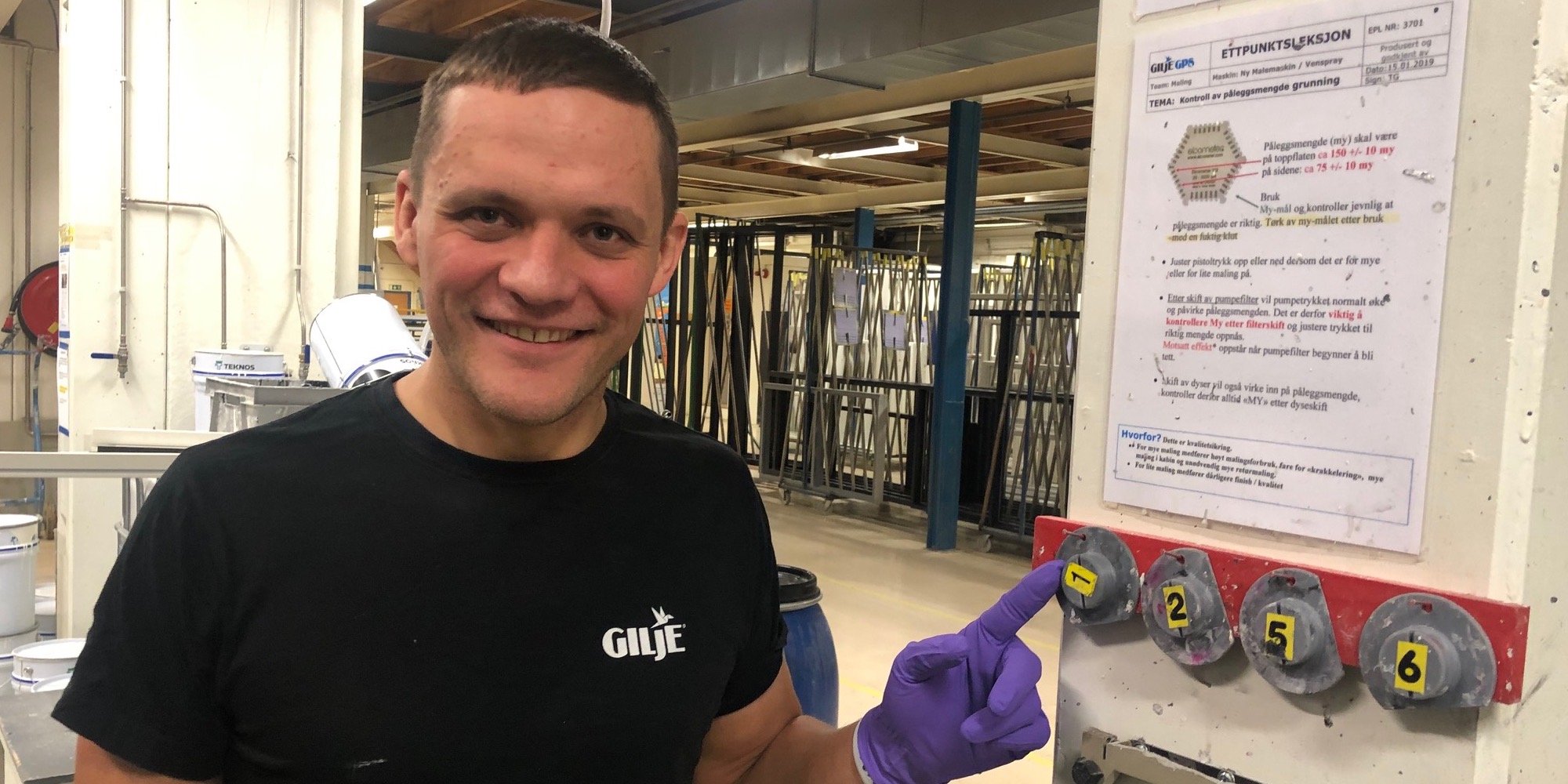
Lean in a building maintenance and renovation company
FEATURE – Visualizing the work, increasing customer focus and changing the way to interact with employees has helped a family-run Dutch building maintenance and renovation firm to transform itself.
Words: Amy Davidson-Oerlemans, Commercial Director, Chris Oerlemans, Financial Director, and Steven Oerlemans, Technical Director, Kloet Onderhoud - Vlaardingen, Netherlands.
We all joined the family business at different times, and perhaps it is no coincidence that our lean journey began when the three of us finally found ourselves working with our father Sjaak. We are very compatible – both in our characters and skills sets – to the point that one might think he engineered us to one day run the business together.
The history of Kloet stretches back nearly 100 years. It started as a painting business (co-owned and run for three generations by the Kloet family and ours) serving the shipbuilding industry here in Vlaardingen, but over time it became a building maintenance and renovation company with 100 employees.
Like every business that has been around for a long time, Kloet wasn’t easy to transform. We took our time doing it, but we eventually achieved a big cultural shift, of which lean is a huge part.
However, our first improvement efforts were only aimed at making the company more efficient. We started by standardizing some of our processes, but soon realized that we were not going to achieve much by simply dictating new rules from the top. It became clear to us that, if we wanted to really transform Kloet, we’d have to get front-line staff and middle management involved.
This led us to introduce our Responsibility at the Base program in 2012. Great insights came up from the conversations we had with our people, and we genuinely thought we were getting through to them. But the program didn’t take off, partly because we were still seeing our improvement efforts (we didn’t call them lean yet) as a tool, partly because of the change fatigue our folks had started to feel. Even though they knew we could be more efficient as a company, they didn’t feel the urge to change because they had worked in the same way for decades. “Why are you not doing things the way your father did them?” is a question we were asked many, many times.
We eventually realized that we had to move away from the traditional approach to management that had been used to run our business (and a million others) for so long. Our father’s generation used so-called “command-and-control” as the de facto approach to management, which meant telling each employee what they had to do every day. No wonder people were not willing to change… we were speaking a language they couldn’t understand! A couple of years ago, therefore, we decided to formally embrace lean thinking in the hope it would show us the way forward. And it did.
VISUALIZING THE WORK
Whenever something went wrong with one of our projects, it took us a long time to get back on track. We had to become more proactive, rather than always fight fires and struggle to make things right. Failure costs had become a concern for us, and that’s why we found it extremely beneficial to focus our lean transformation on quality standards. Defining what quality means to our customers was extremely hard, but it made possible for us to identify deviation in our processes.
But we wanted more than just compliance to standards. We wanted a different culture for Kloet, and knew the only way to achieve it would be to first change our own way of thinking and leading. This insight, which came from the Lean Management Instituut (LMI), was underlined by the results we saw through the Management Drives™ investigation Stefan Visser presented to us. We are family and have similar characters and outlooks, which also means we tend to have the same “blind spots”. These prevented us from involving some of our employees in the company’s new approach. We are now able to adjust our communication and management styles whenever necessary. This has made a huge difference in the way we engage with our teams.
So, we stopped giving answers and started asking questions. At first, not telling people what to do felt impossible, almost a contradiction: how were we supposed to teach them how to behave differently without giving them directions? The more we did it, however, the easier it became. (With this and many other things, we found the support of our coaches from LMI – not only Stefan, but also René Aernoudts – to be absolutely crucial.) After all, many of them were doing their job when the three of us were still in diapers!
It was somehow surprising to see how natural it was for our people to change their way of thinking, whenever we challenged them to do certain things or behave in a different way. Our new approach encouraged them to engage in deep dialogue with their colleagues, and to bring up problems when they occurred. They began to make big steps together, as a team.
Before long, visual management became the engine of our journey: our boards (from those in our obeya room to the those tracking the work of each team) enable us to cascade company objectives while escalating problems that come up at the front line. They ensured lean could reach everyone at Kloet and allow information to travel faster than it ever did. This analogue way of recording and sharing information is as simple as it gets, but it has truly transformed our business. Everybody sees the current state now, and has a clear idea of what they responsibilities are. The amount of information we can gather on a board is astonishing: when, at the end of the day, a team captain takes a picture of the board and shares it with their manager via Whatsapp, the overview of every aspect of the work could not be clearer.
Laying out information on boards (rather than keeping it hidden in Excel sheets) shows people dynamics and problems they previously didn’t have a way of seeing, creates a common interface we can use to communicate, and enables us to continuously change the work for the better.
Indeed, the pace of improvement has accelerated dramatically in the past couple of years, mainly because people no longer hide problems or wait for us to tell them what to do. Instead, they make suggestions and engage in problem solving together. They are owning their processes.
In many ways, visual management is, above all, a symbol of our transformation as leaders: with 25 projects running in every corner of the Netherlands at any given time, we have no way of knowing everything that goes on (no matter how many gemba walks we go on). We simply had to learn to trust our people and rely on the information they give us. It is refreshing, and it’s done wonders for Kloet.
A NEW (FAMILY) BUSINESS
This increased focus on customer needs is paying off, and we can clearly see how lean has become a distinct source of competitive advantage for Kloet: when our clients visit our office and our teams show them around and take them through the boards, for instance, it is clear that everyone in the business (from the interns to the managers) knows what we do, how we do it and why. It has just become a part of the way we think, and clients love to see our people’s pride and commitment. Lean has directly created new business for us in several occasions.
There is more. We have recently attained the ISO 55001 standard, which certifies our ability as a service provider to make strategic analysis on customer needs with regards to asset management. This is a huge milestone for our company, and there is no doubt in our mind about the link between this achievement and the strong relationship we have developed with our customers. Clearly, lean has allowed us to create a connection between customer needs and the work our guys do on the floor each day. This connection is best seen on our team boards, on which we write down the specific wishes of the client for everyone to see (even for the client himself). Think of your experiences with contractors and you’ll know why this is so special!
We often wonder whether the fact that we are a family business – a small one, at that – has been a hindrance or a catalyst for our lean transformation. Being a small company that has been around for nearly a century certainly has its downsides: our people often look at the past rather than the future, and the fact that we are close to everyone who works here often makes it difficult for us to “be the managers”. At the same time, however, we can’t help but recognize that the sense of familiarity and the honesty and loyalty people show us every day are of great help when you try to change things.
Having three siblings sitting in the Board is also quite interesting. As we mentioned earlier, we are very compatible and being able to approach our transformation from different perspectives (operational, financial and communicational) but as a united front has been a great advantage. It’s certainly nice to be able to count on one another, especially when trying to achieve something as big as a cultural shift.
We are very much the same in the way we think and we often complete each other sentences. Of course, that also means we don’t always let each other speak… but that’s just how families work. And we wouldn’t have it any other way.
THE AUTHORS

Read more


ROUND-UP – Looking back at the year that just ended, our editor Roberto Priolo reflects on the power and reach of lean thinking, and offers us a round-up of the best content from 2017.


CASE STUDY – This company in Botswana has embraced lean thinking passionately to build the capacity and ability to deal with higher demand for its converted vehicles. The author tells us about their journey.


CASE STUDY – The story of this Norwegian window and door manufacturer shows how a deep and ongoing commitment to a lean transformation can help a company thrive against all odds.


INTERVIEW – When we think of innovation we rarely think of government, and yet the public sector is in desperate need to modernize and improve. Pierre Pezziardi is on a mission to bring innovation to the French government.

